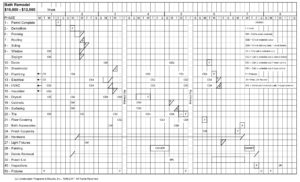I’ve reached the age where I’m either not allowed or not able to do some of the necessary work on our home. I have permission to mow the lawn, drive the tractor, and pull weeds. Everything else is pretty much off-limits. We’ve been hiring out some projects and it’s a frustrating experience.
I received this note some time back from a deck builder asking a question that might be shared by many contractors.
Big fan of your blog, systems, and books – I own both books and multiple systems you sell. One topic I don’t immediately recall reading yet is setting clear expectations with the homeowner regarding which days we’ll be at their home and am certainly struggling here.
Subcontractor Manual
General contractors, get expections in writing. Fully customizable, edit to match company policies.
Order it Here
We work strictly on customer’s exterior of their homes. Oftentimes I let the homeowner know “we’ll be there Tuesday”, or “we’ll be there tomorrow morning, pending weather”, of which they rightfully trust and uphold me to. I strive for self-accountability, but things happen – a guy calls off of work, a hidden condition presents itself, (insert almost anything), etc.
I want to tell the customer when to expect us to be there, but at the same time allow time for contingencies. Would you suggest giving the customer a specific day and/or time, or is it acceptable to leave this more broad, leading with something “we’ll be there at some point next week”, “we should be there towards the end of this week”, “we’ll start your project in the next few days”, and then just show up for work one of those days?
One of the concerns a homeowner has when they’ve hired a contractor is whether they’ll do what they said they’ll do. It is a legitimate concern. Clients don’t know what’s going on in your head, they only know what’s going on with their job.
That’s why you need to set a schedule and keep it. Whenever you get to the job site isn’t good enough, you need to set a schedule and keep them informed.
To do that, write out what needs to happen on your jobs from start to finish. Gantt charts are a great way to plan your jobs, you can create it on paper or use a software program like Tom’s Planner. We went in-depth into making a Gantt chart in this article a few years ago (which is also where we learned about Tom’s Planner).
When a schedule is in writing, it’s easier to stick to that schedule. Gantt Charts, when properly used, will keep you on schedule on well over 90% of the jobs you do. It takes discipline to build and use them for each job, but the return is much happier customers, more jobs done and on time with a higher profit margin and fewer distractions for the contractor.
I don’t suggest telling the homeowner you’ll be there sometime next week, or in the next few days. Be specific on when you’ll arrive and let them know if plans have to change. I definitely don’t suggest just showing up for work, unless you have permission from the owner to do so. Many homeowners aren’t comfortable having someone work at their home, even outside, without them present.
I could ramble on here for several pages but suffice is to say, check the job thoroughly before you start estimating, write a solid contract, build a detailed Gantt Chart, communicate clearly with your client, and make things happen.
The knowledge and experience Michael Stone gained in his 60+ years in construction has helped thousands of contractors improve their businesses and their lives. He is the author of the books Markup & Profit Revisited, Profitable Sales, and Estimating Construction Profitably, and is available for one-on-one consultations.
Download the audio or listen here:


